24 hours in: Florence
As the birthplace of the Renaissance period, opera and even gelato, Florence has enough cultural heritage to fill a whole lifetime. But while Italy’s former capital may at times seem stuck in a 15th-century time warp, its glitzy 21st-century boutiques and bustling cafés ensure the city’s vibrancy is still very much intact. Follow our 24 hours in Florence guide to make the most of what can be an overwhelming city on first viewing.
EARLY RISE
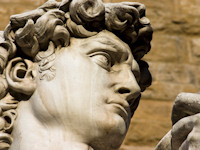 A copy of Michelangelo's David in Piazza della Signoria
A copy of Michelangelo's David in Piazza della SignoriaiStockphoto / Thinkstock
Get up early and head to Piazzale Michelangelo to catch the dying pinkish hues of the sunrise over one of the world’s most handsome urban skylines. It’s well worth the steep trek up the winding path peppered with fragrant orange trees, and you’ll certainly be awake by the time you reach the top (although you can always take a taxi or bus instead). Watch as the city slowly wakes up before walking back down and across the bridge towards the Centro Storico, Florence’s architecture-infused historical quarter that’s bursting with art galleries and museums.
Florence and Renaissance art go hand in hand – after all, the city was home to legendary artists Michelangelo, Leonardo da Vinci, and Sandro Botticelli, to name but a few – leading to its nickname of the ‘cradle of the Renaissance’. A visit to the Tuscan city, therefore, would not be complete without a trip to the Uffizi (Piazzale degli Uffizi 6). As with most attractions in Florence, this famous gallery can become very crowded, but don’t despair; it’s open from 8.15am (closed Mondays) so get here for opening to avoid the crowds – you can also book ahead for tickets to save queuing. With fewer people, you’ll be able to study Botticelli’s The Birth of Venus in full, not over the top of hundreds of heads jostling for the briefest of glances.
BREAKFAST
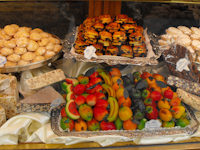 Buy some delectable confectionary at Gilli
Buy some delectable confectionary at Gilli Creative Commons / Putneypics
Having probably had your fill of art for the time being, it’s time to fill your stomach. Wander along the riverside for a look at one of the most iconic bridges in the world, the Ponte Vecchio, which has shops clinging to its ochre-washed sides for dear life. Head along Via Por Santa Maria towards Piazza della Repubblica, stopping off en route at Mercato Nuovo to rub the nose of the wild boar Il Porcellino statue as a promise to return.
Piazza della Repubblica has been a meeting point for artists and intellectuals for centuries and is the perfect place for breakfast. No place sums up the square’s importance more than Caffé Giubbe Rosse (Piazza della Repubblica 13/14) where the futurism art movement originated in the early 1900s, probably over a cup of strong Italian espresso or some tongue-tingling limoncello. Opposite, Gilli, which has been here since 1733, serves up decadent chocolates and golden pastries. Alternatively, sit at a table in the small roof terrace café of La Rinascente department store with its views of terracotta-tiled roofs as far as the eye can see.
MID-MORNING
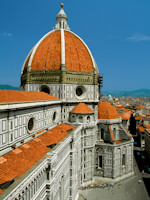 The imposing Duomo in Florence's Centro Storico
The imposing Duomo in Florence's Centro StoricoPhotodisk / Thinkstock
From Piazza della Repubblica, you’ll pass the magnificent Basilica di Santa Maria del Fiore, known simply as Il Duomo due to its tiled dome structure. This is flanked by the birdcage-shaped Battistero di San Giovanni and the towering Giotto’s Campanile – each magnificent examples of 15th-century architecture that dominate the skyline.
Eschew the gathering crowds here and head to the Galeria della’Academia on Via Ricasoli where Michelangelo’s statue David stands. It’s worth the long queues if just to tick it off your ‘been there done that’ list – just try to avoid buying one of the many aprons with David’s figure emblazoned across the front.
There are countless museums to explore in the Centro Storico. Among the most inspiring, however, is Museo di Leonardo da Vinci (Via dei Servi 66), where drawings of numerous contraptions by Italy’s most famous polymath are brought to life in functioning wooden models.
LUNCH
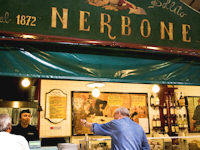 Sample Florentine delights at Nerbone
Sample Florentine delights at NerboneCreative Commons / Tavalli
A short stroll away is the bustling Mercato Centrale, which is animated with the patter of traders and the Fiorentine chatter of locals, a dialect that gave birth to modern-day Italian. After perusing neatly piled stalls of fresh vegetables, butchers’ counters stocked with every imaginable animal part, and delicatessens bulging with prosciutto, sample delicious local produce at one of the many food stalls. The pick of these is Nerbone, a longstanding locals’ haunt that’s famous for its panino con il lampredotto (tripe sandwiches); but its simple pasta dishes and more conventional panino con il bollito (beef sandwiches) are also tasty and cheap.
AFTERNOON
Sated and hopefully not too laden with jars of homemade ragu, bags of citrus fruits and salty strings of salami, it’s time to head to the hub of Florence’s fashion scene, Via de’ Tornabuoni.
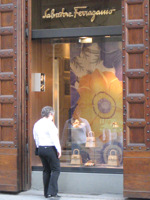 Browse luxury boutiques on Via de’ Tornabuoni
Browse luxury boutiques on Via de’ TornabuoniCreative Commons / dblackadder
Guccio Gucci, founder of the Gucci label, was born here, and the city was also the birthplace of Roberto Cavalli and home to Salvatore Ferragamo, so Florence has fashion coursing through its ancient streets. It’s no surprise therefore that Gucci has a large shop on Via de’Tornabuoni near its Italian fashion rivals Giorgio Armani and Bvlgari.
If the stifling city air, coach loads of tourists and the smell of melting plastic is getting a little overpowering, head to the hills. Take bus 7 from Piazza del Duomo to the hillside town of Fiesole, just 10 minutes away.
The former Etruscan dwelling was ransacked by the Florentines in the 12th century, but the cathedral and bishop's palace remain standing to this day. Take a stroll to the Roman amphitheatre before having a pre-dinner drink at one of the many cafés surrounding the main square in preparation for a walk up the steep meandering slope to San Francesco Monastery. From here, cypress trees grapple for the limelight with opulent country houses and the monastery itself; but the stunning views of the city and beyond remain the centrepiece.
EVENING
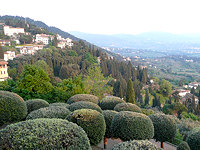 Fiesole offers stunning views of Florence
Fiesole offers stunning views of FlorenceWTG / Jonny Payne
Book a table at the window of La Reggia degli Etrusch (Via San Francesco 18) just yards away from the stunning Fiesole viewpoint. This restaurant has one of the best panoramas of Florence and is the perfect place to see the sun set over the buzzing city below. Choose from local pasta specialities and meat dishes with a modern twist, which include filetto di manzo lardellato all'uva (beef fillet with bacon and grapes). These are accompanied by Tuscan wines, which are unashamedly on show throughout the restaurant – and with wine of this quality who can blame them?
Upon arrival back in the city centre, you may be in time to catch an opera performance at the intimate St Mark’s Anglican Church (Via Maggio 16). Alternatively, opt for a drink and the great Italian pastime of people-watching in one the many bars and cafés lining Piazza della Signoria overlooked by the imposing Palazzo Vecchio, the city’s Romanesque town hall. For a more lively night out, cross the river to the Oltrarno district with its selection of small bars, including Le Volpi e l’Uva (Piazza dei Rossi 1), arguably the city's best wine bar.
To find out more about Florence, visit our Florence travel guide.
Do you have any Feedback about this page?
© 2025 Columbus Travel Media Ltd. All rights reserved. No part of this site may be reproduced without our written permission, click here for information on Columbus Content Solutions.









 You know where
You know where